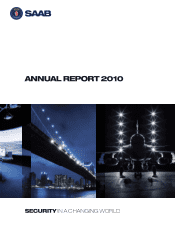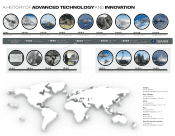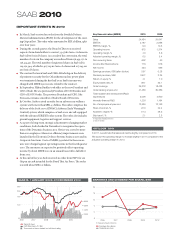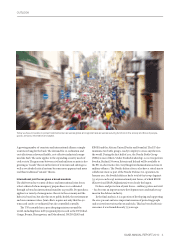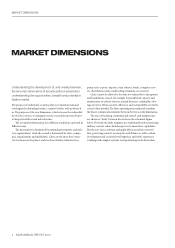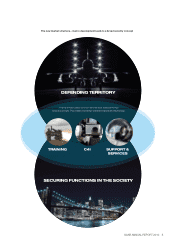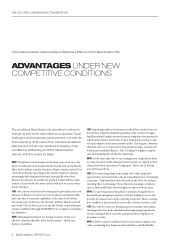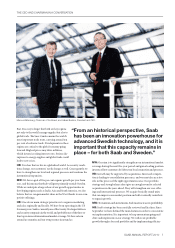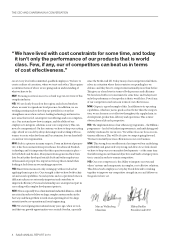Saab 2010 Annual Report Download - page 9
Download and view the complete annual report
Please find page 9 of the 2010 Saab annual report below. You can navigate through the pages in the report by either clicking on the pages listed below, or by using the keyword search tool below to find specific information within the annual report.
The conditions Saab faces in its operations continue to
change, as they do for other defence companies. Fiscal
challenges are forcing many governments to cut their de-
fence spending. At the same time, international defence
alliances and civil security needs are increasing. Chair-
man Marcus Wallenberg and CEO Håkan Buskhe
discuss what this means for Saab.
MW: e global economy improved in many respects in , but
there are still major structural problems that directly and indirectly
aect Saab’s ability to conduct business. Many countries in the West,
especially in Europe, have large debts and scal decits, which is
increasingly aecting how they think strategically about their
defence investments. In an eort to get their budget decits under
control, it is inevitable that more nations will start to reassess their
defence budgets.
HB: One current trend that is becoming more prevalent is the coor-
dination of defence resources between countries and political alli-
ances in order to maintain capabilities at the same level without
increasing costs. In Europe, the extensive military alliance entered
into by the UK and France in and the Nordic cooperation pre-
viously established through NORDEFCO are examples of collabora-
tive initiatives.
MW: Shrinking investments are forcing countries to buy cost-
eective solutions that oer value for the money – in this case,
defence capabilities.
HB: A growing number of customers in the defence market want to
buy the best solutions available regardless of the country of origin.
Smaller national budgets mean that more companies that previously
relied on the defence authorities in their homelands now have to go
out and compete in the international market. is requires, however,
that their defence systems can be integrated into larger systems and
work in international alliances. is is leading to tougher competi-
tion and changing the competitive landscape.
MW: At the same time that we are seeing greater competition, there
is a risk of protectionism when governments have to explain to their
citizens how their tax money is being spent. is is one of the big
unresolved questions.
HB: e overarching, long-term change that is aecting Saab’s
opportunities internationally is the growing importance of emerging
economies. Traditionally we have focused on the West, but defence
spending there is shrinking. We are therefore turning to countries
such as India and Brazil, where budgets are expected to increase.
MW: To a growing extent, the global economy is being driven by
demand from emerging economies, which is leading to more com-
petition for natural assets from a global perspective. is is creating
new conicts of interest and of course aects defence needs as well.
HB: e world’s oceans are playing a greater strategic role in main-
taining production, trade and demand from growing populations.
is has changed threat scenarios and placed more emphasis on
maritime security.
MW: Global security conditions have become more complex, espe-
cially considering developments in North Africa and the Middle
Conversation between Chairman Marcus Wallenberg (MW) and CEO Håkan Buskhe (HB).
ADVANTAGES UNDER NEW
COMPETITIVE CONDITIONS
6 SAAB ANNUAL REPORT 2010
THE CEO AND CHAIRMAN IN A CONVERSATION

